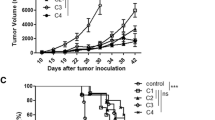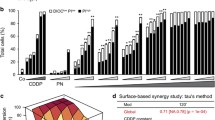Summary
Seven transplantable leukemia lines were established from spontaneous leukemias and screened for 3-[(4-amino-2-methyl-5-pyrimidinyl)methyl]-1-(chloroethyl)-1-nitrosourea hydrochloride (ACNU) sensitivity in DDD mice. Three of them were classified as highly sensitive, two as sensitive and two as resistant to ACNU. A highly sensitive line, DL812, was extensively characterized from a therapeutic point of view. DL812 cells were so invasive as to produced enlargement of spleens and lymph nodes but not local tumors when injected s.c., markedly sensitive to in vitro ACNU exposure and modrately immunogenic. The invasion process of DL812 cells differed with the status of host immunity. Advanced DL812 leukemias were macroscopically completely cured with normalization of spleen and lymph node sizes 3–7 days after an i.p. injection of 0.5 mg ACNU, but more ACNU-resistant leukemias with splenomegaly and enlarged lymph nodes recurred thereafter. Recurring DL812 cells were approximately four times more resistant to in vitro ACNU exposure but maintained similar immunogenicity as compared to the original ones. Permanent cures of advanced leukemias were achieved by ACNU treatment plus subsequent adoptive transfer of immune splenocytes in 15% of diseased mice. The results suggest the importance of host antitumor immunity for permanent cures of highly drug-sensitive leukemias, overcoming drug resistance and relapse.
Similar content being viewed by others
Abbreviations
- ACNU:
-
3-[(4-amino-2-methyl-5-pyrimidinyl)-methyl[-1-(2-chloroethyl)-1-nitrosourea hydrochloride
- FITC:
-
fluorescein-isothiocyanate-conjugated
- Ig:
-
immunoglobulin
- M199:
-
medium 199
- PBS:
-
phosphate-buffered saline solution
References
Arakawa M, Inomata T (1980) Effect of 3-[(4-amino-2-methyl-pyrimidnyl)methyl]-1-(2-chloroethyl)-1-nitrosourea hydrochloride on spontaneous leukemia in AKR mice. Gan-to-Kagakuryoho 7:145–147
Hengst JCD, Mokyr MB, Dray S (1980) Importance of timing in cyclophosphamide therapy of MOPC-315 tumor-bearing mice. Cancer Res 40:2135–2141
Hengst JCD, Mokyr MB, Dray S (1981) Cooperation between cyclophosphamide tumoricidal activity and host antitumor immunity in the cure of mice bearing large MOPC-315 tumors. Cancer Res 41:2163–2169
Horie Y, Arai K, Endoh S, Kuroki T, Takaku A (1987) Specific induction of ACNU-resistance in V79 Chinese hamster cells and C6 rat glioma cells. J Neurosurg 67:553–557
Matsuzawa A, Yamamoto T, Suzuki K (1970) Studies on the DDD mouse with special reference to mammary gland tumors. Jpn J Exp Med 40:159–181
Mokyr MB, Dray S (1983) Some advantages of curing mice bearing a large subcutaneous MOPC-315 tumor with a low dose rather than a high dose cyclophosphamide. Cancer Res 43:3112–3119
Mokyr MB, Brundret RB, Colvin M, Dray S (1986) Ability of cyclophosphamide in the absence of cross-linking activity to exert the immunomodulatory effect required for the cure of mice bearing a large MOPC-315 tumor. Cancer Res 46:3313–3320
Moscow JA, Cowa KH (1988) Multidrug resistance. J Natl Cancer Inst 80:14–20
Mulè JJ, Rosenstein M, Shu S, Rosenberg A (1985) Eradication of a disseminated syngeneic mouse lymphoma by systemic adoptive transfer of immune lymphocytes and its dependence upon a host component(s). Cancer Res 45:526–531
Powis G (1985) Cancer chemotherapy. II. Laboratory to clinic. In: Farmer B, Walker JM (eds) The molecular basis of cancer. Crom Helm, London Sydney, pp 287–324
Satoh M, Huh N, Horie Y, Thomale J, Rajewsky MF, Kuroki T (1987) Acquisiton of resistance to 1-(4-amino-2-methyl-5-pyrimidinyl)methyl-3-(2-chloroethyl)-3-nitrosourea hydrochloride in V79 cells through increase removal of O 6-alkylguanine. Jpn J Cancer Res 78:1094–1099
Shimizu F, Arakawa M (1975) Effect of 3-[(4-amino-2-methyl-5-pyrimidinyl)ethyl]-1-(2-chloroethyl)-1-nitrosourea hydrocholide on lymphoid leukemia L-1210. Gann 66:149–154
Shimizu F, Arakawa M (1978) Antitumor activity of 3-[(4-amino-2-methyl-pyrimidinyl)methyl]-1-(2-chloroethyl)-1-nitrosourea hydrochloride in a variety of experimental tumors. Gann 69:545–548
Takubo T, Masaoka T, Nakamura H, Ueda T, Shibata H, Yoshitake J (1978) ACNU treatment of blood malignancy. Gan-to-Kagakuryoho 5:599–603
Takubo T, Namiuchi S, Ueda T, Shibata H, Nakamura H, Masaoka T, Yoshitake J, Ishigami S (1981) Effect on 3-[(4-amino-methyl-5-pyrimidinyl)methyl]-1-(2-chloroethyl)-1-nitrosorea hydrochloride (ACNU) on chronic myelocytic leukemia. Gan-to-Kagakuryoho 8:290–293
Tanaka S, Matsuzawa A, Kato H, Esaki K, Sudo K, Yamanouchi K (1987) Inbred strains of mice maintained at the Institute of Medical Science, University of Tokyo. Jpn J Exp Med 57:241–245
Thompson JA, Peace DJ, Klarnet JP, Kern DE, Greenberg PD, Cheever MA (1986) Eradication of disseminated murine leukemia by treatment with high-dose interleukin 2. J Immunol 137:3675–3680
Winn HJ (1961) Immune mechanisms in homotrasplantation. II. Quantitative assay of immunological activity of lymphoid stimulated by tumor homografts. J Immunol 86:228–239
Author information
Authors and Affiliations
Additional information
This work was supported in part by a grant-in-aid for cancer research from the Ministry of Education, Science and Culture, Japan
Rights and permissions
About this article
Cite this article
Takeda, Y., Sekiguchi, M. & Matsuzawa, A. Importance of antitumor immunity for complete cure of highly drug-sensitive leukemia in mice. J Cancer Res Clin Oncol 115, 221–228 (1989). https://doi.org/10.1007/BF00391693
Received:
Accepted:
Issue Date:
DOI: https://doi.org/10.1007/BF00391693




